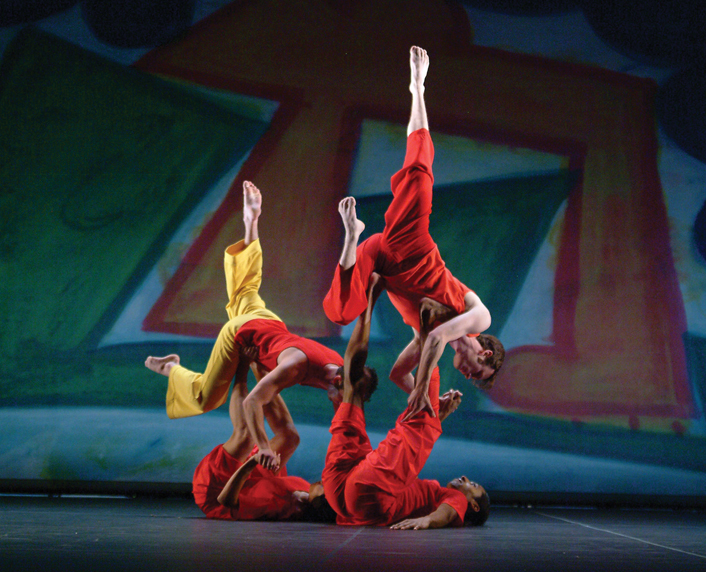Trisha Brown Dance Company: Proscenium Works 1979-2011 and In Plain Site - Vancouver Ballet Society
- Home
- Reviews 2014 - 2019
- Trisha Brown Dance Company: Proscenium Works 1979-2011 and In Plain Site

by Pia Lo
Trisha Brown has been building movement since the 1960s, creating work that examines how the human body moves in relation to the space around it. Like the Judson Dance Theater artistic collective, of which she was a founding member, Brown’s work rejects dramatic narrative, focusing instead on building complex movement patterns from pedestrian gestures. Brown has described herself as “a bricklayer with a sense of humour.” Yet, for all her structural rigour, it’s the brick she lays askew that connects her work to the cadence of the human experience. In February, performances at Meany Hall in Seattle, not far from Aberdeen, the city where Brown was born and raised, concluded a worldwide tour in which the Trisha Brown Dance Company gave the final performances of several of Brown’s works created specifically for theatre stages. In future, the company plans to focus on her site-specific pieces, like In Plain Site, performed in the foyer of the Seattle Art Museum.
The Meany Hall evening opened with the hypnotic Son of Gone Fishin’ (1981), Brown’s first piece set to music, after some 20 years of choreographing. Excerpts from Robert Ashley’s Atalanta (Acts of God) laid electronic beats and synthesizer notes in the black proscenium space where six dancers shimmered in gold-tinted T-shirts and loose pants (the original designs by Judith Shea remade for this tour). Through complex sequences of pedestrian gestures — a leg lift, an arm swing, light hops and torso rotations sprung from momentum — the dancers casually flipped and reversed their phrases, intertwined and unravelled, never colliding. The changing puzzle-like structure was invigorating and suspenseful, from which glimmers of unison — a gesture downstage mirrored by another upstage — occasionally emerged like quiet, soothing breaths.
You can see us (1995), performed by Cecily Campbell and Jamie Scott, was a response to a solo made in 1994 in which Brown had danced with her back to the audience. Though there wasn’t explicit interaction, the pair was deeply connected by synchronization, as one danced with her back to the audience and the other, mirroring the movement, faced forward.
Rogues (2011) was comprised of two simultaneous duets, one performed by Marc Crousillat and Stuart Shugg, and the other by Campbell and Scott. Though each only interacted with their partner, the audience sees the whole composition of all four. Their limbs swept and swung with characteristic fluidity, building momentum to partnered lifts that were as lofty as they were steady. Momentarily, they deliberately fell out of sync, then promptly returned to unison, as if to prove unwavering commitment to one another that also brought a sense of comfort and reassurance. Rogues was set to piano, harmonica and wind instrument notes that faded in and out against a hum of grinding static, composed by Alvin Curran.
PRESENT TENSE (2003) added a touch of play and theatricality. A painted backdrop of bold shapes of red, green, orange and blue, designed by American artist Robert Rauschenberg (a frequent collaborator of Brown’s) accented seven dancers dressed in solid coloured tops and pants. Dancers became puzzle pieces, interlocking into three-dimensional structures with calculated balance; then, with casual ease, a dancer is flipped head-over-feet.
In another acrobatic feat, two dancers jumped into splits, held mid-air by the ensemble while their front legs intersected at 90 degrees. Later, a dancer balanced his outstretched body horizontally with his stomach on the flexed feet of his partner, who was lying on his back. Suddenly, the dancer on top flopped, playfully limp, over the feet as if to say that even in such rigour, it’s not above them to embrace some silliness. John Cage’s Sonatas and Interludes, for prepared piano, reiterated the theme of creating new structures.
The foyer of the Seattle Art Museum, where 13 pieces or excerpts were adapted for the long, rectangular space, gave audience members a chance to view the dance from ground level or from the balconies above. In an excerpt of Set and Reset (1983), three dancers walked alongside a wall holding another dancer horizontally above their heads, whose feet “walked” in the same rhythm against the wall. Sticks (1973) positioned dancers against posts and tasked them to shift positions while balancing long wooden sticks. The piece doesn’t finish until all the dancers have completed their task, which generated audience support as one person shouted cues to help a dancer finish.
Group Primary Accumulation with Movers (1973) created challenge and suspense when a “mover” overlapped a dancer’s legs on top of another’s, while both persisted in dancing identical phrases of movement lying on the ground. They were left, subject to the mover’s whim, who placed a third dancer nearby such that her limbs, dancing the same phrases while standing, intersected the pair. The dancers were never named, and the piece was void of any reference to time and place, but out of these precarious circumstances, Brown has created narratives and characters.
DI SUMMER 2016


One Reply to “Trisha Brown Dance Company: Proscenium Works 1979-2011 and In Plain Site”
Trisha Brown Dance Company | Globe Dancer
[…] Read the review in the Summer 2016 issue of Dance International. […]
Comments are closed.